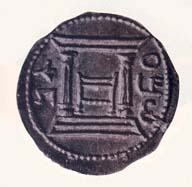Image Details

Zev Radovan
Bar-Kokhba coins from the Second Jewish Revolt (132 C.E.) against Rome are commonly thought to depict the Jerusalem Temple. The distinctive trapezoidal shape at the top of the didrachma coin mirrors the lintel over the portal of the Temple’s facade. The coin apparently shows a view of the Temple through the Portico to the Sanctuary; in front of the Sanctuary’s open doors is displayed the Table of the Shewbread.
Bar-Kokhba coins provide evidence that the Yehosah ossuary, along with others from the Second Temple period, may contain depictions of the Temple, author Asher Grossberg suggests. Not only was it possible to depict the Temple just two generations after its destruction, but features shown on the coins (the multi-beamed lintel, the columns) are also shown on the Yehosah ossuary. The Table of the Shewbread is absent on the ossuary, then, because the ossuary shows the Sanctuary doors as closed.
